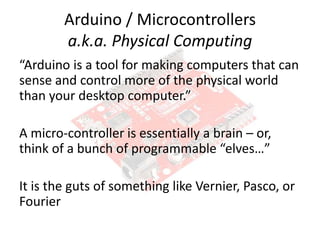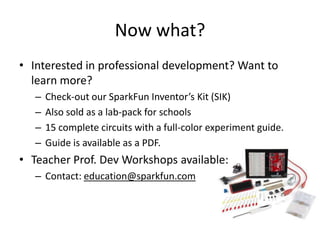Maker Science with Arduino and SparkFun Electronics @NSTA14 Boston
- 1. http://sfe.io/r72 Jeff Branson Education Outreach Coordinator Email: jeff.branson@sparkfun.com Derek Runberg Curriculum Curator Email: derek.runberg@sparkfun.com @sparkfun #nsta14
- 2. PauseŌĆ” Before we move any further, letŌĆÖs make sure that we all know each other in this room? Please introduce yourself to the person(s) sitting in your general vicinity. Tell them a few things about yourself, maybe: ŌĆō where youŌĆÖre from ŌĆō what you teach ŌĆō why youŌĆÖre here ŌĆō what you hope to get out of thisŌĆ”.
- 3. About Us At SparkFun, our focus is all about creation, innovation, and sharing information. Open Source Hardware is at the core of our business. We emphasize researching, re- mixing, adapting, making improvements, and sharing with the world!
- 7. ŌĆ£ Teacher s t hat makeŌĆ” Make gr eat t eacher sŌĆØ -Anonymous
- 8. Arduino / Microcontrollers a.k.a. Physical Computing ŌĆ£Arduino is a tool for making computers that can sense and control more of the physical world than your desktop computer.ŌĆØ A micro-controller is essentially a brain ŌĆō or, think of a bunch of programmable ŌĆ£elvesŌĆ”ŌĆØ It is the guts of something like Vernier, Pasco, or Fourier
- 9. What can this thing do? Remember, think programmable ŌĆ£elvesŌĆØ We can use this to: - Turn on lights - Interface cameras (take photos) - Log sensor data (temp, pressure, humidity, lightŌĆ”) - Communicate with your PC and the internet (a.k.a. Internet of Things) - Take Science Fair to the next levelŌĆ”
- 10. How it works? 01010011 01110000 01100001 01110010 01101011 01000110 01110101 01101110 SERIAL DATA @ 9600 baud
- 11. Hardware Configurations / Connections WhatŌĆÖs a Pin? 14 general digital input / output pins 6 analog input pins (Pins A0 ŌĆō A5) Nitty Gritty: Powered off anything from 7 ŌĆō 15V DC Voltage Regulator provides 5V and 3.3V Standard TTL logic ŌĆō 5V is HIGH, and 0V is LOW.
- 12. Getting started ŌĆó Download Arduino from: www.arduino.cc/download ŌĆó Follow their directions on installation.
- 13. Startup Arduino IDE ŌĆó Double-click on either the Arduino Icon or wherever you installed (saved) the Arduino program.
- 14. Plug in your RedBoard (Arduino)
- 15. Lesson #0 ŌĆō Setting up Arduino 1.Setup Board ŌĆōArduino Uno 1.Setup COM Port ŌĆōPC ŌĆō Highest COM # ŌĆōMac ŌĆō /dev/tty.usbserial-A####xXx
- 16. Tools ’āĀ Board ’āĀ Arduino Uno Setup Board
- 17. Tools ’āĀ Serial Port Setup COM Port PC ŌĆō Highest COM # Mac ŌĆō /dev/tty.usbserial- A####xxx
- 18. Anatomy of code General syntax: ŌĆō Case-sensitive ŌĆō Semi-colons ŌĆō Curly-brackets void functionName()
- 19. Just the basics Turning an LED on and offŌĆ”
- 20. Open Challenges 1) Create a heartbeat ŌĆō a realistic one! 2) What is the fastest blink that your eye can detect? What is the frequency of this blink? Now, move the LED back and forth ŌĆō do you see a ŌĆ£trailŌĆØ? What are some interesting scientific investigations you can explore with this? 1) What about making a timer?? ŌĆō blink the LED for 10 seconds and then stop! 2) What other ideas?
- 21. Introducing the Danger Shield WhatŌĆÖs a Shield?
- 22. Sensing ŌĆō ║▌║▌▀Żr ŌĆō AnalogRead(A0)
- 23. Serial Monitor 01010011 01110000 01100001 01110010 01101011 01000110 01110101 01101110 SERIAL DATA @ 9600 baud
- 24. Sensing ŌĆō Light ŌĆō AnalogRead(A3)
- 25. Sensing ŌĆō Temp ŌĆō AnalogRead(A4) This sensor: TMP36 has a sensitivity of 10 mV / ┬░C = 100┬░C / V and is 750 mV at 25 ┬░C.
- 26. Converting between ADC value to voltage?
- 28. Preview of Digital SandBox ║▌║▌▀Żr / PotentiometerSwitch Motor / Speaker Out Push Button Microphone Light Sensor Temp Sensor LED Array RGB LED Arduino
- 29. Now what? ŌĆó Interested in professional development? Want to learn more? ŌĆō Check-out our SparkFun InventorŌĆÖs Kit (SIK) ŌĆō Also sold as a lab-pack for schools ŌĆō 15 complete circuits with a full-color experiment guide. ŌĆō Guide is available as a PDF. ŌĆó Teacher Prof. Dev Workshops available: ŌĆō Contact: education@sparkfun.com
- 30. Questions? email: jeff.branson@sparkfun.com twitter: @sparkfun Interested in any of this? E-mail us about our 20% educator discount ŌĆō education@sparkfun.com
Editor's Notes
- What is science? What is the nature of science? ŌĆō Inquiry, Investigation, ExperimentationŌĆ” But, weŌĆÖre past the ages of using rulers, stop watches, and old school techniques to investigate our world. How are real scientists doing it?
- Plug it in. FTDI is Serial buffer, 5V, GND, reset. 40-50 miliAmps source 3.3V system. 9 pins broken out. PWM and analogs. You can reconfigure analog ins to be outputs.
- Talk about different board types
- Talk about different board types
- IŌĆÖm not sure if this one works. It did not work on the Danger Shields that we had in the classroom. ’üī
- This is a new learning platform for Arduino to be released in the next few months. It integrates 5 white LEDs, an RGB LED, a microphone, light sensor, temp sensor, slider, switch, button, and two general purpose I/O ports.






























